Apple trees, with their bountiful yield and beautiful blossoms, are a rewarding addition to any landscape. Taking proper care of these trees, however, is not just about watering and harvesting the fruits. One needs a comprehensive understanding of various indispensable aspects like pruning, pest and disease control, and correct fertilization practices. Pruning is crucial for regulating the tree’s balance and allowing efficient sunlight penetration, while an understanding of common pests and diseases will ensure the tree’s overall health. Moreover, proper fertilization guided by the understanding of the specific nutritional needs of apple trees bears directly on their fruit production.
Pruning Apple Trees
Unwrapping the Art of Pruning Apple Trees: A Gateway for Optimal Growth
Ever passed by an apple orchard and wondered how those trees manage to bear such abundant fruit? It’s no magic trick, but a careful, deliberate skill that’s been honed over time – pruning. When it comes to apple trees, productive growth is hinged significantly on the principle of proper pruning.
Why Prune?
The goal of an effective pruning regimen is primarily to promote optimal health and fruit production of the apple trees. Pruning helps remove dead, damaged, or crossing branches, which can compete for nutrients and create a crowded canopy, possibly blocking sunlight from reaching internal parts of the tree.
The Pruning Strategy
The best time to prune apple trees is typically late winter or early spring, just before new growth starts, but when the threat of extreme cold has passed. This pruning timing not only staves off potential disease infestation but also balances the tree’s rejuvenation vigor.
Beginners might find it useful to visualize the tree as a goblet with a hollow center, choosing branches that enhance this open structure and creating a strong framework for fruiting.
Right Tools for the Right Job
Undoubtedly, the right tools play an essential role in safe and efficient pruning. Secateurs are perfect for cutting smaller branches and twigs, while loppers are used for branches up to 2 inches thick. A pruning saw comes in handy for hefty branches. Always keep these tools sharp and clean to make neat, precise cuts and minimize disease spread.
The Pruning Process
- Remove all dead, diseased, or damaged wood. The goal is to allow optimal energy flow to healthy branches for flourishing growth.
- Remove any branches crossing or growing in towards the middle of the tree. As mentioned earlier, fostering an open center is vital for sufficient light penetration and air circulation.
- An effective pruning scheme aims to shorten side branches by around a third. Application of this technique encourages clusters of fruit buds to sprout closer to the tree’s main trunk.
- Regulate the height of apple trees for more effortless picking. Trim the leader and upper branches to keep the tree within reach, curbing strain or possible damage during harvest.
- Tame vigorous branches. The branches shooting straight up (often called water sprouts) or growing horizontally at a 90-degree angle (suckers) should be pruned out entirely as they hinder fruitful growth.
- Last but not least, thin out the fruit. Yes, this involves removing healthy apples! Hand-thinning in early summer will address over-crowding, direct energy to remaining fruits and reduce limb breakages under hefty weight.
Every apple tree is different, wearing a unique hat of intricacy and personality. Thus, pruning is not a one-size-fits-all task. Appropriate patience and attention to detail can transform a fledgling amateur into a seasoned horticulturist. Embrace the journey and look forward to harvesting those crispy, sun-ripened apples in your backyard. Happy pruning!

Pest and Disease Control
Perfecting the Pruning Process: Expertise Beyond the Basics for Apple Trees
Pruning apple trees is more than just a task—it becomes a work of art for the dedicated hobbyist. After mastering the basics, you’ll find there’s always more to learn about this intricate process to maximize tree health and fruit yield. So, let’s delve deep into understanding the curling tongues of branches and the silent whispers of an apple tree.
In the journey from novice to maestro, you’ll uncover that the type of apple tree you’re dealing with plays a crucial role in your pruning strategy. While the basic premise remains the same – maintaining that goblet like structure – different species each come with their unique quirks. It’s important to research the specific needs and patterns of your particular tree type. Some varieties respond better to aggressive pruning, while others need a gentler touch.
There’s a subtle art to knowing when a branch needs more than just a trim. An overly vigorous branch, although healthy in appearance, can block sunlight and air circulation from the lower branches. Most often found in younger, fast-growing trees, these branches need a more stern approach, with substantial shortening or complete removal. Remember, the key is balance.
Next, pay attention to the tree’s dormant buds. These often-overlooked components are the future lifelines of your apple tree. Dormant buds hold the potential for new branches or flowering spur, vital for fruit production. By making pruning cuts just above these buds, you encourage controlled growth in your desired direction.
Water sprouts versus suckers—an essential distinction in apple tree pruning that merits attention. While both are vigorous growths stealing valuable energy from your tree, their removal approach differs. Water sprouts, growing on the tree’s trunk or old branches, need tender prompt removal to avoid unnecessary scarring. Suckers, on the other hand, pop up from the base of the apple tree and require firm snipping off at ground level.
When tackling tangled branches, patience truly is a virtue. Instead of hurriedly pruning everything away, take your time to trace the tangled mess back to the source. This way, you could save healthy limbs and correct the tree’s structure, preventing future entanglements.
As far as equipment maintenance goes, keeping your tools sharp and clean is just as important as the pruning process itself. Clean tools prevent the transfer of disease between trees, and sharp tools make clean cuts that heal quickly. Remember to disinfect your tools regularly, especially if you’ve pruned a diseased branch. Dull blades can cause tearing or crushing, damaging the tree and making it susceptible to infections.
To wrap up, let’s remember that pruning is not a one-time event but a continuous process. It’s about understanding the language of your apple tree, providing the right care at the right time, and taking joy in the fruits of your labor—literally! The road to mastering apple tree pruning can be a long and winding one, filled with trial and error. However, the satisfaction derived from a well-pruned, healthy, productive apple tree makes the journey worthwhile. So, keep nurturing that growing skill while ensuring your apple tree’s overall well-being!

Proper Fertilization for Apple Trees
Nourishing your apple trees with the right fertilizers is just as pivotal as pruning. Fertilizers provide the necessary nutrients to help apple trees grow robustly and produce healthy, abundant fruit. There are three main types of nutrients that apple trees commonly need: nitrogen (N), phosphorus (P), and potassium (K). Together, they are known as N-P-K, the trilogy of plant nutrients.
Nitrogen is essential because it encourages robust leaf growth, which, in turn, aids photosynthesis. Meanwhile, phosphorus promotes strong root development and flower formation, which are imperative for fruit production. Lastly, potassium strengthens the overall plant health, allowing it to resist diseases and pest attacks.
Based on the tree’s needs and the soil’s nutrient content, you would choose one of the following three types of fertilizers:
- Granular fertilizers are scattered on the ground around the tree. They slowly release nutrients over time, providing sustained nourishment for your apple tree. These fertilizers are quite popular due to their ease of application and long-lasting effect.
- Liquid fertilizers, as their name suggests, are diluted in water and then either sprayed onto the leaves (foliar feeding) or applied to the soil (root feeding). These are fast-acting and quickly absorbed by the tree. They’re great for addressing specific nutrient deficiencies or giving a quick boost to your tree during critical growth stages.
- Time-release fertilizers are a slight variant of granular ones. They are coated in a special material that breaks down over time, releasing the nutrients slowly. This is perfect for apple trees as it provides steady nourishment over several months, with just a single application.
Organic fertilizers, such as compost, manure, bone meal, or fish emulsion, are an environmentally friendly option. They enrich the soil, improve its structure, and provide a broad range of nutrients to the tree. But they take time to break down and impact the soil chemistry, making their results slower to manifest, but usually more sustainable.
A soil test is the best way to determine which nutrients your apple trees need and allow you to choose the best type of fertilizer. However, apple trees typically benefit from a balanced N-P-K fertilizer (for example, a 10-10-10 mix).
Remember to apply fertilizer in the late winter or early spring before the new growth starts, when the tree can use the nutrients most effectively. Rarely is fall fertilizing necessary unless the tree is deficient in a specific nutrient or located in a frost-prone region.
Watch out for over-fertilization. Excessive nitrogen, for instance, can lead to bountiful leaf growth at the expense of fruit production. Too much of any nutrient can damage the roots or even kill the tree.
Pairing attentive pruning with considerate fertilization creates a harmonious environment for your tree to flourish, bundle in blossoms, and bounty with fruits. By understanding and implementing these best practices, your apple trees will likely reward you with a healthy, fruitful harvest. So, get that green thumb working, enthusiasts!

Understanding and implementing these core principles of apple tree care is essential for ensuring the health and productivity of these trees. The art and science of pruning help in shaping the tree and promoting growth, while a keen awareness of possible pests and diseases enables preemptive action to guard against such threats. Knowledge of proper fertilization practices equips one with the know-how of catering to the tree’s nutritional needs, thus ensuring a copious and quality yield. Caring for apple trees can be a gratifying experience, transforming you from a mere observer to a diligent cultivator of these bountiful gifts of nature.